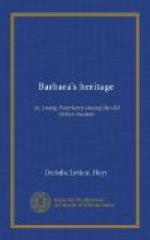We take afternoon tea at the English Mrs. Watson’s, beside the foot of the Scala di Spagna, close to whose top tradition tells us that shameless Messalina, Claudius’s empress, was mercilessly slain.
And so it is throughout the city. Tradition, legend, and romance have peopled every place we visit. Wars, massacres, and horrible suffering have left a stain at every step. Love and faith and glorious self-sacrifice have consecrated the ways over which we pass. And though we do not give definite thought to these things always, yet all the time the city is weaving her spell about our minds and hearts, and we suddenly arouse to find that, traditional or historic, civilized or barbarous, conqueror or conquered, ancient or modern, she has become Cara Roma to us, and so will be forevermore.
Thus it had been with Mrs. Douglas and Mr. Sumner, and so it now was with the young people of their household who had come hither for the first time.
The days flew fast. It was almost difficult to find time when all could get together for their art study. Mr. Sumner had told them at first that here they would study under totally different conditions from those in Florence, so separated are the works of any particular artist save Michael Angelo.
They had already visited individually, as they chose, those historic palaces in which are most important family picture-galleries, such as the Colonna, Farnese, Doria, Corsini, Villa Borghese, etc., but they wished to go all together to the Vatican to hear Mr. Sumner talk of Raphael’s works, and right glad were they when finally a convenient time came.
They walked quickly through many pictured rooms and corridors until they reached the third room of the famous picture-gallery, where they took seats, and Mr. Sumner said, in a low voice:—
“I did not wish to come here immediately after we had studied Michael Angelo’s frescoes. It was better to wait for a time, so utterly unlike are these two great masters of painting. I confess that I never like to compare them, one with the other, although their lives were so closely related that it is always natural to do so. Their characters were opposite; so, also, their work. One sways us by his all-compelling strength; the other draws us by his alluring charm. Michael Angelo is in painting what Dante and Shakespeare are in poetry, and Beethoven in music; Raphael is like the gentle Spenser and the tender Mozart. Michael Angelo is thoroughly original; Raphael possessed a peculiarly receptive nature, that caught something from all with whom he came into close contact. Michael Angelo strove continually to grow; Raphael struggled for nothing. Michael Angelo’s life was sternly lonely and sorrowful; Raphael’s bright, happy, and placid. Michael Angelo lived long; Raphael died in early manhood.
“Still,” he continued, after a moment, as he noted the sympathetic faces about him, “although I have mentioned them, I beg of you not to allow any of these personal characteristics or distinctions to influence you in your judgment of the work of these two. Forget the one to-day as we study the other.




